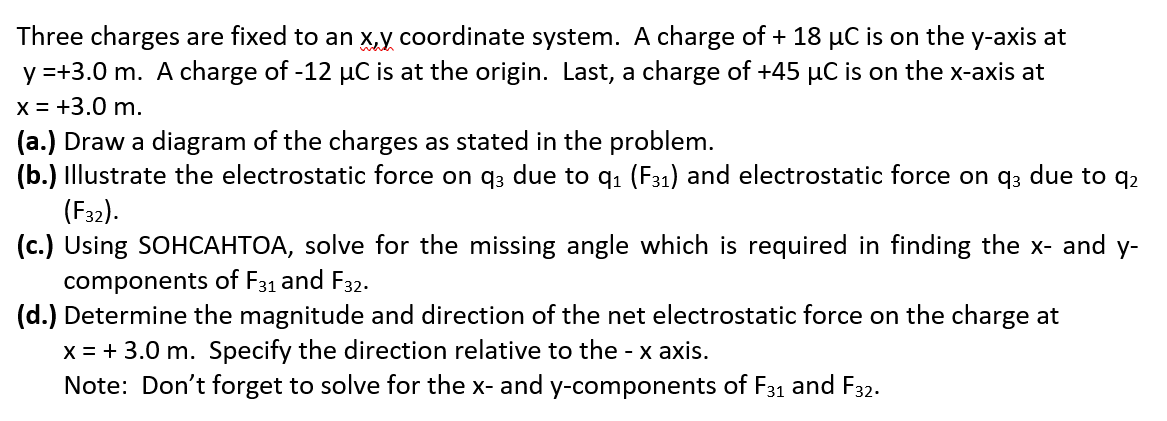Three charges are fixed to an x,y coordinate system. A charge of + 18 µC is on the y-axis at y =+3.0 m. A charge of -12 µC is at the origin. Last, a charge of +45 µC is on the x-axis at X = +3.0 m. (a.) Draw a diagram of the charges as stated in the problem. (b.) Illustrate the electrostatic force on q3 due to q1 (F31) and electrostatic force on q3 due to q2 (F32). (c.) Using SOHCAHTOA, solve for the missing angle which is required in finding the x- and y- components of F31 and F32. (d.) Determine the magnitude and direction of the net electrostatic force on the charge at X = + 3.0 m. Specify the direction relative to the - x axis. Note: Don't forget to solve for the x- and y-components of F31 and F32.
Three charges are fixed to an x,y coordinate system. A charge of + 18 µC is on the y-axis at y =+3.0 m. A charge of -12 µC is at the origin. Last, a charge of +45 µC is on the x-axis at X = +3.0 m. (a.) Draw a diagram of the charges as stated in the problem. (b.) Illustrate the electrostatic force on q3 due to q1 (F31) and electrostatic force on q3 due to q2 (F32). (c.) Using SOHCAHTOA, solve for the missing angle which is required in finding the x- and y- components of F31 and F32. (d.) Determine the magnitude and direction of the net electrostatic force on the charge at X = + 3.0 m. Specify the direction relative to the - x axis. Note: Don't forget to solve for the x- and y-components of F31 and F32.
Principles of Physics: A Calculus-Based Text
5th Edition
ISBN:9781133104261
Author:Raymond A. Serway, John W. Jewett
Publisher:Raymond A. Serway, John W. Jewett
Chapter19: Electric Forces And Electric Fields
Section: Chapter Questions
Problem 28P: Three equal positive charges q are at the comers of an equilateral triangle of side a as shown in...
Related questions
Question

Transcribed Image Text:Three charges are fixed to an x,y coordinate system. A charge of + 18 µC is on the y-axis at
y =+3.0 m. A charge of -12 µC is at the origin. Last, a charge of +45 µC is on the x-axis at
X = +3.0 m.
(a.) Draw a diagram of the charges as stated in the problem.
(b.) Illustrate the electrostatic force on q3 due to q1 (F31) and electrostatic force on q3 due to q2
(F32).
(c.) Using SOHCAHTOA, solve for the missing angle which is required in finding the x- and y-
components of F31 and F32.
(d.) Determine the magnitude and direction of the net electrostatic force on the charge at
X = + 3.0 m. Specify the direction relative to the - x axis.
Note: Don't forget to solve for the x- and y-components of F31 and F32.
Expert Solution
This question has been solved!
Explore an expertly crafted, step-by-step solution for a thorough understanding of key concepts.
This is a popular solution!
Trending now
This is a popular solution!
Step by step
Solved in 2 steps with 2 images

Knowledge Booster
Learn more about
Need a deep-dive on the concept behind this application? Look no further. Learn more about this topic, physics and related others by exploring similar questions and additional content below.Recommended textbooks for you

Principles of Physics: A Calculus-Based Text
Physics
ISBN:
9781133104261
Author:
Raymond A. Serway, John W. Jewett
Publisher:
Cengage Learning

College Physics
Physics
ISBN:
9781305952300
Author:
Raymond A. Serway, Chris Vuille
Publisher:
Cengage Learning

College Physics
Physics
ISBN:
9781285737027
Author:
Raymond A. Serway, Chris Vuille
Publisher:
Cengage Learning

Principles of Physics: A Calculus-Based Text
Physics
ISBN:
9781133104261
Author:
Raymond A. Serway, John W. Jewett
Publisher:
Cengage Learning

College Physics
Physics
ISBN:
9781305952300
Author:
Raymond A. Serway, Chris Vuille
Publisher:
Cengage Learning

College Physics
Physics
ISBN:
9781285737027
Author:
Raymond A. Serway, Chris Vuille
Publisher:
Cengage Learning

Physics for Scientists and Engineers with Modern …
Physics
ISBN:
9781337553292
Author:
Raymond A. Serway, John W. Jewett
Publisher:
Cengage Learning

Physics for Scientists and Engineers
Physics
ISBN:
9781337553278
Author:
Raymond A. Serway, John W. Jewett
Publisher:
Cengage Learning

Physics for Scientists and Engineers: Foundations…
Physics
ISBN:
9781133939146
Author:
Katz, Debora M.
Publisher:
Cengage Learning